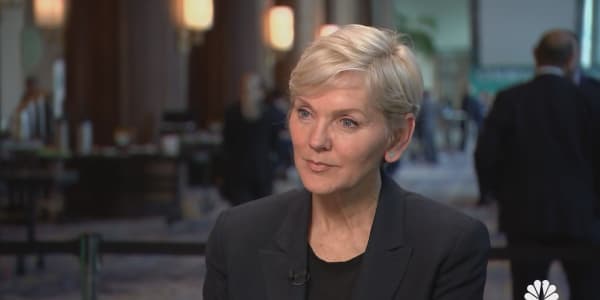
Sinking oil prices have only made Mexico's goal of rebuilding its energy industry with foreign investment and revamping Pemex — its beleaguered national energy company — more challenging.
"We're submitting [cuts] to the board later this week, as every oil company in the world is doing, so we adjust to the new price of oil," said Pemex CEO José Antonio González Anaya at this week's annual IHS CERAWeek energy conference. The plan assumes oil prices for Mexican crude of $25 per barrel, down from $50 last year, González Anaya said.
Mexican President Enrique Peña Nieto with González Anaya, who had headed the government's Social Security Institute before taking the helm of the national oil and gas company.
Nieto announced at IHS CERAWeek an expedited schedule of December for a fourth round of investor bids on deep-water deposits in the Gulf of Mexico.
Mexico Energy Secretary Pedro Joaquin Coldwell said the energy reform pushed by Nieto was long needed and is critical because of the decline in the energy sector.
"It changes the hydrocarbon paradigm, and it changes the electrical sector paradigm as well," he said. Coldwell said Mexico's electric rates had been 75 percent more than those in the U.S., but it is bringing them down with cheaper natural gas from the U.S. It is also working to add new pipeline capacity to bring in additional natural gas.
"We had lost 1 million barrels of daily production over 10 years," he said.
According to the International Energy Agency, Mexico produces about 2.6 million barrels a day, and the future of its production will depend on whether it gets needed investment.
"If they don't, we're going to anticipate a continued decline," said Neil Atkinson, head of the IEA's oil market division.
"We're working with Pemex as fast as we can to present 'farm-outs.' This is part of the strategy to strengthen Pemex," said Lourdes Melgar, Deputy Secretary of Energy for Hydrocarbons, Mexico Ministry of Energy, at this week's IHS CERAWeek energy conference.
Pemex is expected to remain focused on shallow water, where it is strongest. Production at Pemex's giant shallow-water Cantarell field, the second-largest in the world, has been falling since its peak in 2014. González Anaya described the decline as occurring "fairly rapidly — more rapidly than we would like."
Pemex, which in recent years has funded as much as one-third of the Mexican national budget, is being hit by roughly $5 billion in cost cuts, and it is expected to submit assets that can become part of ventures with outside companies or sold. In recent ratings actions, Moody's Investor Service has forecast that Pemex will provide most of its operating cash to fund "well above" 20 percent of Mexico's annual budget for the next four to five years.
Melgar said the government will be offering 10 deep-water blocks — four in the Perdido area, south of Texas; and six in the frontier area of the Salina del Istmo basin. One Salina block is expected to be natural gas, she said.
There are currently 30 contracts to private bidders from three other bidding rounds for shallow-water exploration and extraction and onshore mature fields. Bidders also can include Mexican companies.
Ali Moshiri, president of Chevron Africa and Latin America Exploration and Production, also spoke at CERAWeek. He called the Mexican reform "tremendous for the industry" and a necessary step toward energy integration in North America.
"Geology doesn't know the border," he said.
Nieto also said as of April, companies other than Pemex will be able to import fuel.
"Mexico imports 53 percent of its gasoline, so this is a huge opportunity," Melgar said.
She said outside companies will be able to use Pemex pipelines and other equipment for gasoline or diesel imports if they pay a tariff to Pemex. Pemex could also sell the fuel infrastructure, in addition to collecting tariffs.







